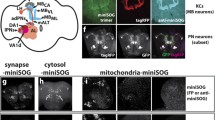Abstract
Scanning electron microscope (SEM) helps to analyse the surface of any cell or organ by magnifying it several times. SEM analysis provides an indispensable tool for people working with a small model organism like Drosophila. Various morphological abnormalities originated in different body parts during development can be visualized after SEM analysis. The images generated from SEM make it easy to characterize the morphological defect. SEM is recently attached with Energy-Dispersive X-ray Spectroscopy (EDX/EDS). This allows detecting all the metals present within the organ. The current protocol describes the fixation of Drosophila head, haltere, hemolymph and gut for SEM analysis. We are also describing the metal analysis of the gut using EDS or EDX analysis.
Access this chapter
Tax calculation will be finalised at checkout
Purchases are for personal use only
Similar content being viewed by others
References
Bozzola JJ, Russell LD (1999) Electron microscopy: principles and techniques for biologists. Jones & Bartlett Learning, Sudbury
Egerton RF (2011) Electron energy-loss spectroscopy in the electron microscope. Springer Science & Business Media, New York
Williams DB, Carter CB (1996) The transmission electron microscope. In: Transmission electron microscopy. Springer, pp 3–17
Wollman DA, Irwin KD, Hilton GC, Dulcie L, Newbury DE, Martinis JM (1997) High-resolution, energy-dispersive microcalorimeter spectrometer for X-ray microanalysis. J Microsc 188(3):196–223
Kutchko BG, Kim AG (2006) Fly ash characterization by SEM–EDS. Fuel 85(17–18):2537–2544
Goldstein JI, Newbury DE, Michael JR, Ritchie NW, Scott JHJ, Joy DC (2017) Scanning electron microscopy and X-ray microanalysis. Springer, New York
Choudhary OP, Malik P (2017) Scanning electron microscope: advantages and disadvantages in imaging components. Int J Curr Microbiol Appl Sci 6:1877. https://doi.org/10.20546/ijcmas.2017.605.207
McMullan D (1995) Scanning electron microscopy 1928–1965. Scanning 17(3):175–185
Reed SJB (2005) Electron microprobe analysis and scanning electron microscopy in geology. Cambridge university press, Cambridge
Henchcliffe C, García-Alonso L, Tang J, Goodman CS (1993) Genetic analysis of laminin A reveals diverse functions during morphogenesis in Drosophila. Development 118(2):325–337
Alone DP, Tiwari AK, Mandal L, Li M, Mechler BM, Roy JK (2004) Rab11 is required during Drosophila eye development. Int J Dev Biol 49(7):873–879
Geisbrecht ER, Haralalka S, Swanson SK, Florens L, Washburn MP, Abmayr SM (2008) Drosophila ELMO/CED-12 interacts with Myoblast city to direct myoblast fusion and ommatidial organization. Dev Biol 314(1):137–149
Tokunaga C, Gerhart JC (1976) The effect of growth and joint formation on bristle pattern in D. melanogaster. J Exp Zool 198(1):79–95
Lees AD, Waddington CH (1942) The development of the bristles in normal and some mutant types of Drosophila melanogaster. Proc R Soc Lond Ser B-Biol Sci 131(862):87–110
Yasuzumi G, Deguchi N (1958) Submicroscopic structure of the compound eye as revealed by electron microscopy. J Ultrastruct Res 1(3):259–270
Mishra M, Knust E (2012) Analysis of the Drosophila compound eye with light and electron microscopy. In: Retinal degeneration. Springer, pp 161–182
Cribbs D, Benassayag C, Randazzo F, Kaufman T (1995) Levels of homeotic protein function can determine developmental identity: evidence from low level expression of the Drosophila homeotic gene proboscipedia under Hsp70 control. EMBO J 14(4):767–778
Benassayag C, Plaza S, Callaerts P, Clements J, Romeo Y, Gehring WJ, Cribbs DL (2003) Evidence for a direct functional antagonism of the selector genes proboscipedia and eyeless in Drosophila head development. Development 130(3):575–586
Szabad J, Bellen HJ, Venken KJ (2012) An assay to detect in vivo Y chromosome loss in Drosophila wing disc cells. G3 2(9):1095–1102
Johnson SA, Milner MJ (1987) The final stages of wing development in Drosophila melanogaster. Tissue Cell 19(4):505–513
Foelix R, Stocker R, Steinbrecht R (1989) Fine structure of a sensory organ in the arista of Drosophila melanogaster and some other dipterans. Cell Tissue Res 258(2):277–287
Lanot R, Zachary D, Holder F, Meister M (2001) Postembryonic hematopoiesis in Drosophila. Dev Biol 230(2):243–257
Stofanko M, Kwon SY, Badenhorst P (2010) Lineage tracing of lamellocytes demonstrates Drosophila macrophage plasticity. PLoS One 5(11):e14051
Pappus SA, Ekka B, Sahu S, Sabat D, Dash P, Mishra M (2017) A toxicity assessment of hydroxyapatite nanoparticles on development and behaviour of Drosophila melanogaster. J Nanopart Res 19(4):136
Silva J, Boleli I, Simões Z (2002) Hemocyte types and total and differential counts in unparasitized and parasitized Anastrepha obliqua (Diptera, Tephritidae) larvae. Braz J Biol 62(4A):689–699
Acknowledgements
JB is thankful to BT/PR21857/NNT/28/1238/2017 for financial support. MM lab is supported by Grant No. BT/PR21857/NNT/28/1238/2017, EMR/2017/003054, Odisha DBT 3325/ST(BIO)-02/2017.
Author information
Authors and Affiliations
Corresponding author
Editor information
Editors and Affiliations
Rights and permissions
Copyright information
© 2020 Springer Science+Business Media, LLC, part of Springer Nature
About this protocol
Cite this protocol
Bag, J., Mishra, M. (2020). Analysis of Various Body Parts of Drosophila Under a Scanning Electron Microscope. In: Mishra, M. (eds) Fundamental Approaches to Screen Abnormalities in Drosophila. Springer Protocols Handbooks. Springer, New York, NY. https://doi.org/10.1007/978-1-4939-9756-5_16
Download citation
DOI: https://doi.org/10.1007/978-1-4939-9756-5_16
Published:
Publisher Name: Springer, New York, NY
Print ISBN: 978-1-4939-9755-8
Online ISBN: 978-1-4939-9756-5
eBook Packages: Springer Protocols




